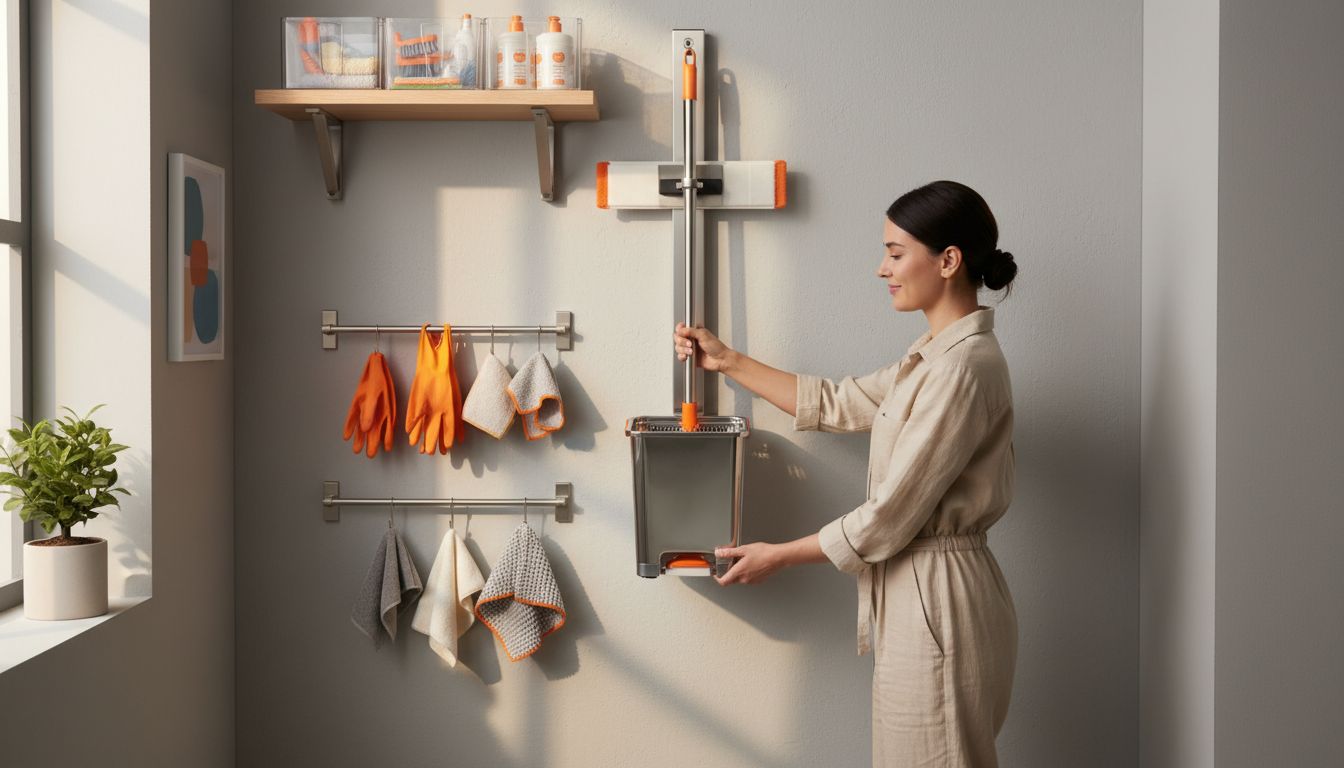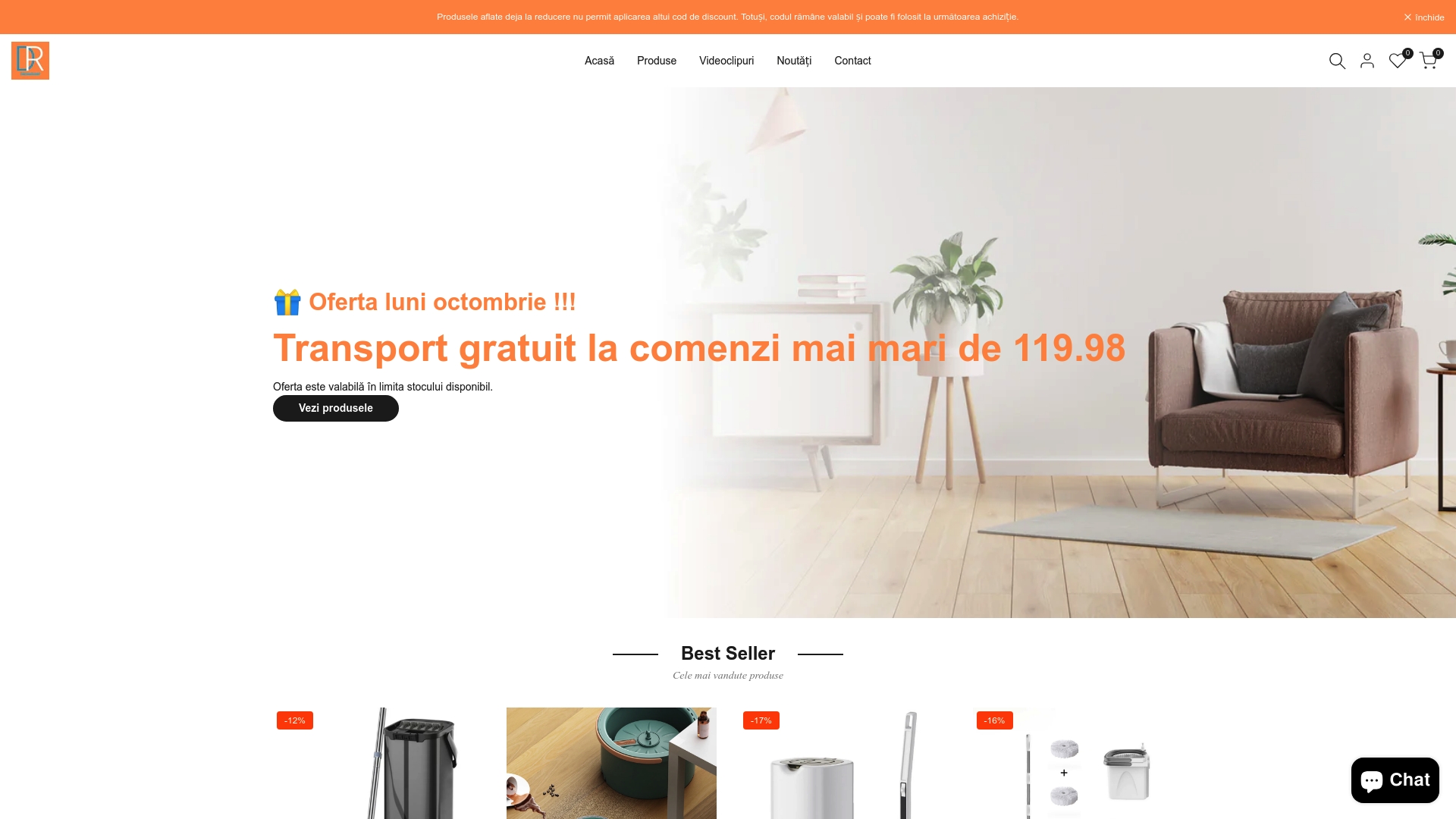Did you know that the CDC reports improper cleaning equipment storage can lead to a sharp increase in bacterial contamination? Many people overlook how a simple mop and bucket can harbor germs if not cared for the right way. Taking the time to clean, organize, and store your cleaning tools correctly makes a real difference in keeping your home healthy and your cleaning tasks easier.
Table of Contents
- Step 1: Clean And Dry Mop And Bucket Thoroughly
- Step 2: Select An Appropriate Storage Location
- Step 3: Arrange Mop And Bucket To Maximize Space
- Step 4: Secure Tools For Safety And Accessibility
- Step 5: Check Storage Area For Cleanliness And Convenience
Quick Summary
| Key Point | Explanation |
|---|---|
| 1. Clean and disinfect mop and bucket regularly | Properly clean out your mop and bucket after each use to reduce germ contamination. Use hot water and disinfectant for thorough cleaning. |
| 2. Choose a dry, ventilated storage location | Select a storage area that is consistently dry and well-ventilated to prevent mold and bacterial growth. Avoid damp spaces. |
| 3. Utilize vertical storage solutions | Maximize your storage space by using wall-mounted racks or hanging systems, keeping tools easily accessible and preventing moisture buildup. |
| 4. Secure cleaning tools safely | Store cleaning supplies in lockable compartments to enhance safety, especially in households with children. Arrange items for easy reach. |
| 5. Regularly inspect and maintain storage area | Conduct monthly checkups of your storage area for cleanliness and functionality, ensuring it remains organized and free of bacteria. |
Step 1: Clean and Dry Mop and Bucket Thoroughly
Maintaining clean and dry mop equipment is crucial for preventing the spread of germs and ensuring effective cleaning. According to the CDC, proper cleaning and storage of your mop and bucket can significantly reduce contamination risks.
Start by emptying your bucket completely after each cleaning session. Rinse the bucket with hot water to remove any dirt or cleaning solution residue. Use a mild disinfectant or all-purpose cleaner to scrub the inside and outside of the bucket thoroughly. Pay special attention to corners and edges where grime can accumulate.
Next, focus on your mop head. According to CDC guidelines, mop heads should be thoroughly rinsed and wrung out after each use. If your mop head is machine washable, run it through a hot water cycle with a disinfecting detergent. For non machine-washable mops, soak in a solution of hot water and sanitizing cleaner, then rinse completely.
Pro Tip: Always hang your mop head and bucket to air dry completely before storing. Moisture can breed bacteria and unpleasant odors.
Store your cleaning equipment in a well-ventilated area with good air circulation. Avoid storing mops or buckets in damp, dark spaces which can promote mold and mildew growth. By following these simple steps, you will extend the life of your cleaning tools and maintain a hygienic cleaning routine.
Step 2: Select an Appropriate Storage Location
Choosing the right storage location for your cleaning equipment is more than just finding an empty space. According to CDC guidelines for infection control, designated storage areas are critical for preventing cross contamination and maintaining equipment hygiene.
Look for a storage spot that meets several key criteria. The location should be dry with consistent temperature and good air circulation. Avoid areas near direct heat sources like radiators or sunny windows that might cause mop materials to degrade. According to professional cleaning recommendations, your storage space should also be clean and free from dust or additional moisture.
Ideal storage locations include dedicated utility closets, laundry rooms, or well-ventilated cabinets. These spaces should keep your cleaning tools upright and separated to prevent moisture buildup and potential bacterial growth.
 If you have limited space, consider wall mounted holders or over the door organizers that allow mops and buckets to hang freely.
If you have limited space, consider wall mounted holders or over the door organizers that allow mops and buckets to hang freely.
Pro Tip: Never store cleaning equipment directly on the floor where they can collect additional dirt or become breeding grounds for bacteria.
Remember that proper storage is not just about finding a convenient spot. It is about protecting your cleaning tools and ensuring they remain hygienic and ready for their next use. By selecting a strategic storage location, you will extend the life of your equipment and maintain a clean efficient cleaning routine.
Here’s a summary of ideal qualities for storage locations:
| Quality | Why It Matters | Recommendations |
|---|---|---|
| Dry Environment | Prevents mold & mildew | Use ventilated closets or cabinets |
| Good Air Circulation | Limits moisture buildup | Choose open shelves or racks |
| Consistent Temperature | Extends equipment lifespan | Avoid heat sources or sunlight |
| Cleanliness | Reduces contamination | Clean space regularly |
| Accessibility | Improves workflow | Store items upright, off the floor |
Step 3: Arrange Mop and Bucket to Maximize Space
Organizing your cleaning equipment efficiently can transform a cluttered storage area into a well-structured cleaning station. According to CDC guidelines for equipment management, strategic arrangement not only saves space but also improves overall cleaning workflow and equipment maintenance.
Start by thinking vertically. Wall mounted racks or over the door hanging systems can dramatically reduce floor space usage while keeping your mop and bucket easily accessible. Consider adjustable storage solutions that allow you to customize spacing based on your specific equipment sizes. According to professional cleaning recommendations, vertical storage helps prevent moisture buildup and keeps cleaning tools in optimal condition.
Group similar items together and use stackable containers or compact storage units that can nest inside each other. Lightweight plastic containers with secure lids work exceptionally well for storing smaller cleaning accessories like gloves, sponges, and microfiber cloths. If you have multiple mops or buckets, invest in modular storage systems that can be reconfigured as your cleaning needs change.
Pro Tip: Always leave some breathing room between stored items to prevent moisture trapping and potential bacterial growth.
Remember that efficient storage is about creating a system that works for your specific space and cleaning routine. By implementing smart organizational strategies, you will not only maximize your storage area but also make your cleaning process smoother and more enjoyable.
Step 4: Secure Tools for Safety and Accessibility
Ensuring your cleaning tools are both secure and easily accessible requires thoughtful planning and smart storage solutions. According to CDC guidelines for equipment management, proper storage is not just about organization but also about maintaining safety and preventing potential accidents.
Start by investing in storage options with lockable compartments. This approach mirrors professional cleaning recommendations for managing potentially hazardous cleaning solutions. Consider cabinets or storage containers with integrated locks that prevent children or unauthorized individuals from accessing cleaning chemicals or sharp tools. For smaller spaces, lockable storage boxes or wall mounted cabinets with secure latches can provide an excellent solution.
Arrange your tools in a way that prioritizes both safety and convenience. Place frequently used items at eye level or in easily reached locations. Keep heavier items on lower shelves to prevent potential falling hazards. Lightweight and less frequently used tools can be stored on higher shelves. Use clear labels to identify contents and potential hazards, which helps everyone in the household understand proper handling and storage protocols.
Pro Tip: Install childproof locks on storage areas containing cleaning supplies to ensure additional safety for families with young children.
Remember that securing your cleaning tools is about creating a system that protects both your equipment and the people around you. By implementing thoughtful storage strategies, you will create a safer more organized cleaning environment that works efficiently for everyone.
Step 5: Check Storage Area for Cleanliness and Convenience
Maintaining a clean and well organized storage area for your cleaning tools is more than just an aesthetic choice. According to CDC guidelines for equipment management, regular cleaning and maintenance of storage spaces are essential for preventing bacterial growth and ensuring optimal hygiene.
Begin with a thorough inspection of your storage area. Look for signs of moisture accumulation, dust buildup, or potential mold growth. Remove all cleaning equipment and completely wipe down shelves, racks, and storage containers using a disinfectant solution. Pay special attention to corners and hard to reach areas where dirt and bacteria can easily accumulate. Professional cleaning recommendations emphasize the importance of creating a sanitized environment for storing your cleaning tools.
Evaluate the current layout of your storage space and consider its functionality. Are your most frequently used items easily accessible? Do you have sufficient ventilation to prevent moisture buildup? Consider installing additional shelving, hooks, or organizational systems that can improve both the cleanliness and convenience of your storage area. Modular storage solutions can help you adapt your space as your cleaning needs change.
Pro Tip: Schedule a monthly deep clean of your storage area to prevent dust and bacteria from compromising your cleaning equipment.
Remember that a well maintained storage space is not just about organization. It is about creating an environment that supports efficient cleaning and helps your tools remain in top condition. By investing a little time in regular maintenance, you will ensure your cleaning equipment stays clean, accessible, and ready for action.
Keep Your Cleaning Tools Organized and Ready with DreamRamp
Struggling with where and how to store your mop and bucket efficiently? This article highlights common challenges like preventing moisture buildup, avoiding contamination, and maximizing limited storage space. You deserve a storage solution that keeps your equipment dry, clean, and safe while making your cleaning routine easier and faster.
At DreamRamp.ro, we understand those pain points. Find innovative mop and bucket sets designed with clean water and dirty water separation. These smart products simplify your cleaning and help keep your tools hygienic between uses. Plus, explore accessories that help you store everything neatly in dry, ventilated spaces, protecting your investment and health.

Upgrade your home cleaning experience now. Browse top-quality cleaning tools and storage solutions at DreamRamp. Discover how easy it is to keep your mop and bucket spotless, organized, and accessible every day. Visit us today and take the first step to a fresher, more efficient cleaning routine.
Frequently Asked Questions
How can I keep my mop and bucket as clean as possible?
To keep your mop and bucket clean, rinse them thoroughly after each use, and use a mild disinfectant to scrub both inside and outside. Implement this routine immediately after cleaning to minimize contamination risks.
What’s the best way to store a mop and bucket in a small space?
In a small space, consider using wall-mounted racks or over-the-door organizers to maximize vertical storage. Hang your mop and bucket to free up floor space and prevent moisture accumulation.
How can I protect my cleaning tools from moisture and mold?
To protect your cleaning tools, store them in a dry environment with good air circulation, away from damp areas. Regularly check your storage space for moisture and clean any build-up to reduce mold risks.
What should I consider when selecting a storage location for my mop and bucket?
When selecting a storage location, look for a space that is dry, well-ventilated, and free from dust. Ensure the area allows for upright storage and easy accessibility for your cleaning routine.
How can I efficiently organize my cleaning supplies with my mop and bucket?
Organize your cleaning supplies by grouping similar items together and using stackable containers. Utilize vertical storage solutions to keep everything accessible, while leaving some space between items for airflow.
How often should I clean my mop and bucket storage area?
You should clean your mop and bucket storage area at least once a month to prevent bacteria growth and maintain hygiene. Conduct a thorough inspection and wipes down surfaces to keep everything in optimal condition.









